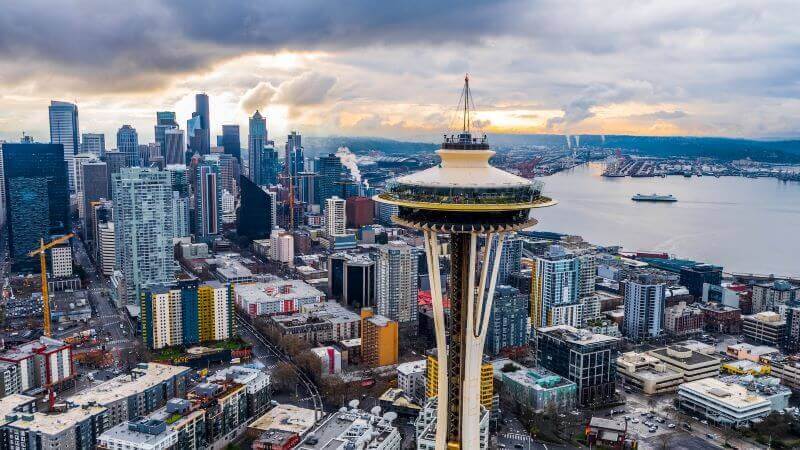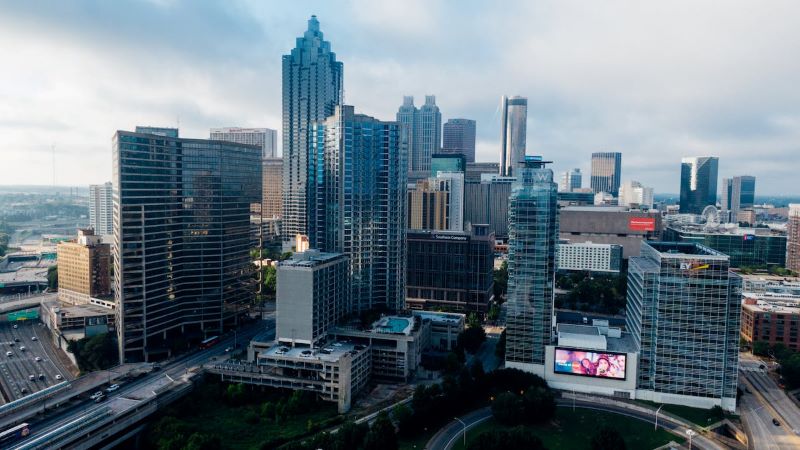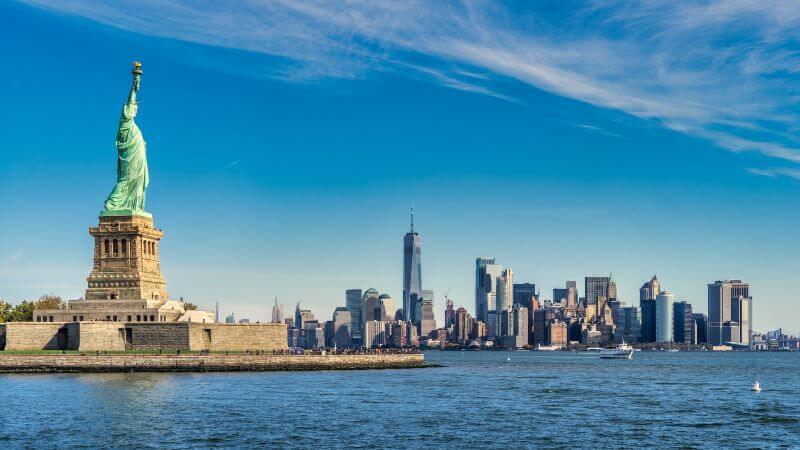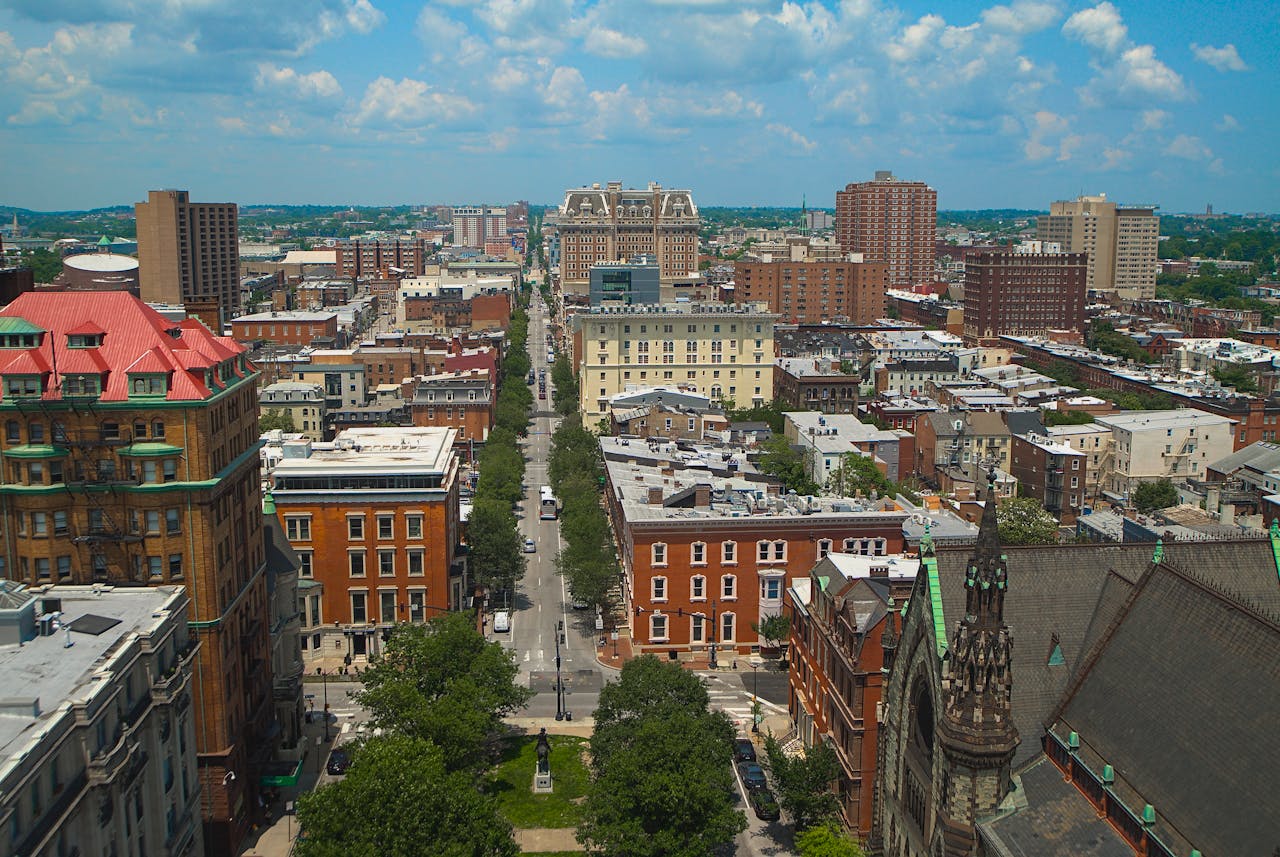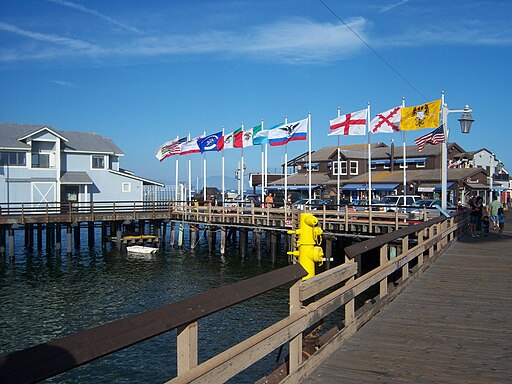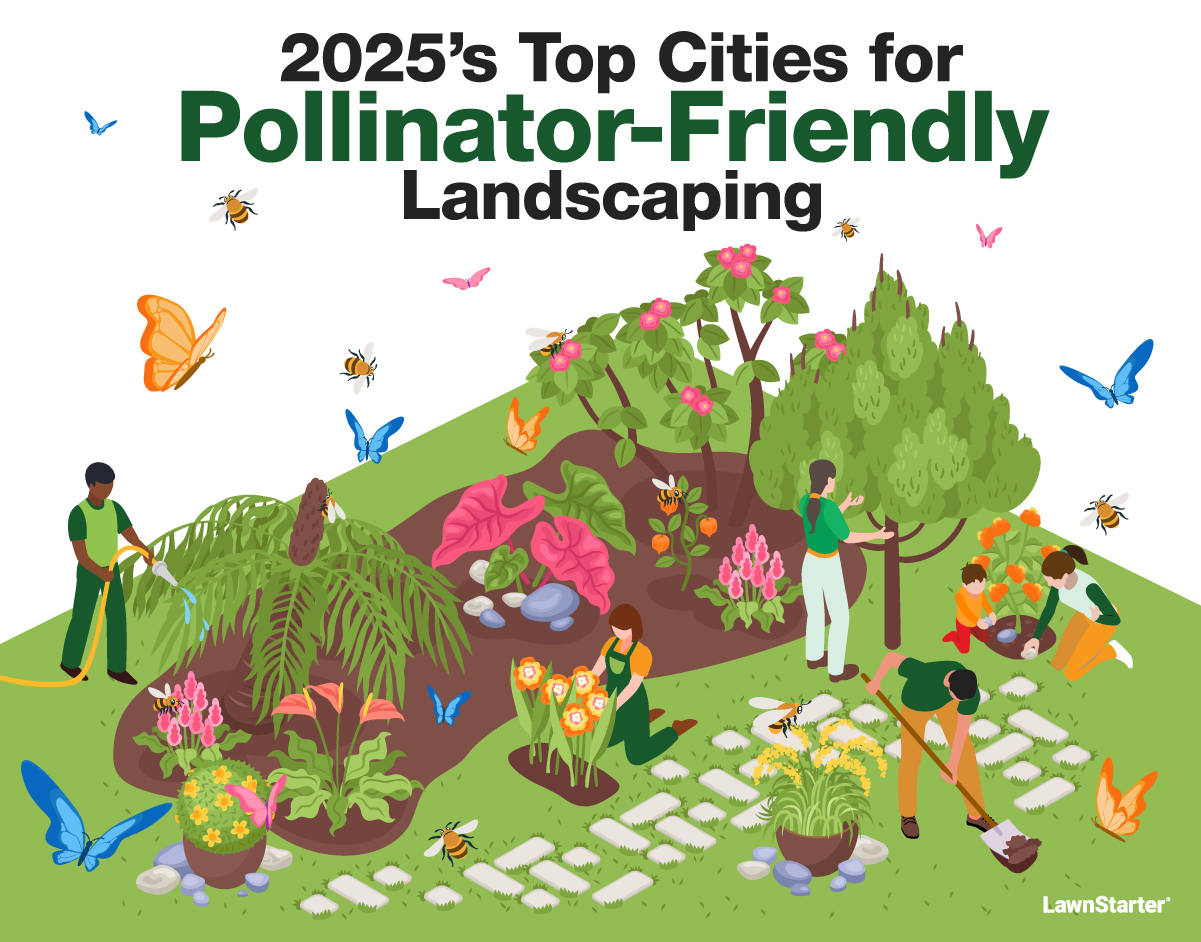
Which U.S. cities are using their lawns and gardens to invite and sustain pollinators?
To mark National Pollinator Month, LawnStarter used 11 different metrics to rank 2025’s Top Cities for Pollinator-Friendly Landscaping.
Why is LawnStarter ranking pollinator-friendly cities? No Mow May is shifting to Slow Mow Summer to protect bees and butterflies.
Flutter through our ranking and insights below. To learn how we ranked the cities, see our methodology.
Contents
- Top 5 Close Up
- City Rankings
- Ranking Overview
- Ask the Experts
- Methodology
- Turn Your Landscape into a Pollinator Paradise
Top 5 Close Up
Check out the slideshow below for highlights on each of our top 5 cities for attracting pollinators.
City Rankings
See how each city fared in our ranking:
Ranking Overview
Cities like Seattle (No. 1), Atlanta (No. 2), and Baltimore (No. 4) score at the top thanks to policies protecting pollinators, urban gardens and other spaces dedicated to pollinators, and high local interest in pollinator-friendly landscaping, according to Google searches.
Cities in 27 states in our ranking — including California, Texas, and New York— received a boost in our rankings for their pollinator-friendly policies. These consist of promoting the use of native plants, creating pollinator habitat protection and management strategies, and funding research initiatives.
49 cities have their own local ordinances for pesticide-free zones or restrictions. Connecticut and Maryland were the first two states to ban neurotoxic pesticides called neonicotinoids back in 2016. Now, 8 states in our ranking have restricted these substances that are harmful to bees.
54 cities in our ranking are affiliates of Bee City USA, meaning their local governments have committed to pollinator conservation.
Near the bottom of our ranking are cities in Southeastern states like Alabama, Florida, and Louisiana because they lack legislation in pollinator conservation and other sustainable initiatives.
Ask the Experts
We turned to a panel of experts to learn more about pollinator-friendly landscaping and what might deter pollinators from dancing around your yard. Explore their insights below.
- What 3 plants should people landscape with to attract pollinators to their property?
- What other landscaping elements are beneficial to pollinators?
- What landscaping elements might be deterring pollinators from visiting?
- How can homeowners benefit from attracting pollinators to their backyard?
- Regarding concerns of bird flu spreading from wild birds, what considerations should homeowners take when designing a pollinator-friendly backyard?
- Can homeowners be pollinator-friendly while deterring annoying pests like mosquitoes? If so, how?





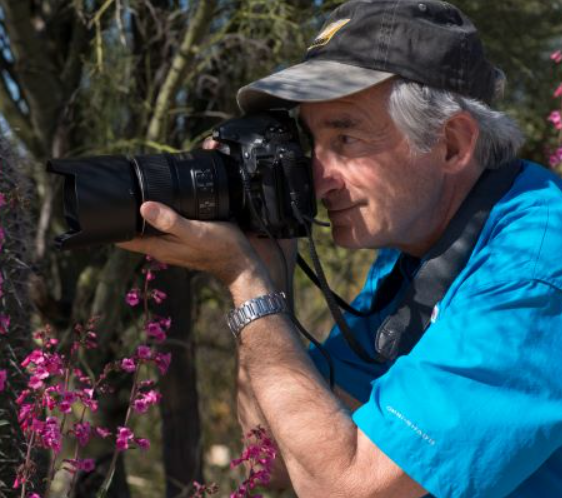

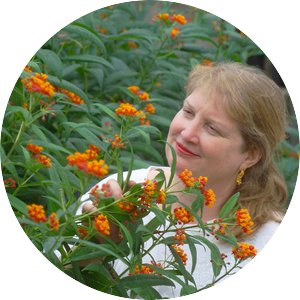


What 3 plants should people have on their property?
I have to punt on this one! It’s a lot of pressure to narrow it down to just three…and I would also like to see pollinator-friendly gardeners agonize a bit less about plant choices. I would encourage gardeners to select plants they personally enjoy and that thrive on their property—and the same three species won’t check those boxes for everyone.
The key things are to have neighborhoods where there are a lot of native plants, where something is always in bloom, and to accept feedback from your pollinator neighbors.
If there’s a plant they love, maybe plant some more of it. If there’s a plant that never seems to get much traffic, or that just doesn’t thrive, maybe it’s time to look for a replacement. If there’s a gap during the growing season where you and your neighbors have nothing in bloom—look for a plant that blooms then.
What other landscaping elements are beneficial to pollinators?
Here I’m thinking mainly of bees—and not just honey bees, but the other 4,000 species of bees in North America. Most of them nest in the soil, and some of them nest in dead wood or plant stems.
Some of them collect plant material—like sap, leaf pieces, and petals—to line their nests. So while flowers are an essential part of a pollinator habitat, so are nesting resources. Keep an eye out for nesting native bees, and protect the resources they are using to do it!
If you’re low on dead wood or dead stems, you can introduce these intentionally, or consider adding a small, well-maintained ‘bee hotel’ to your landscape. As an aside, it’s worth noting that ground-nesting bees are generally mild-mannered and do not share the aggressive tendencies of yellowjacket wasps!
What landscaping elements might be deterring pollinators from visiting?
I see a lot of strong statements on the internet about what time of year pollinator gardeners should tidy up the dead stems of perennial plants. Fall and winter have been traditional times for garden cleanup. A lot of resources say that for wildlife-friendly gardening, you should wait until late spring. Late spring is actually not a good time, though!
Colleagues and I did some new research to address the conflicting recommendations, and we found that stems are not occupied in their first winter. It is fine to cut them then. By spring, solitary stem-nesting bees are beginning to move into the previous year’s stems. So if you wait until spring to cut back, you risk destroying these new nests.
An ideal scenario is to tidy up in late winter, but leave some stems in place as a stubble about 12-18” tall. These cut ends will increase opportunities for solitary, stem-nesting bees to enter these stems and start nesting there in the spring.
Also on the topic of nesting, soil-nesting bees don’t generally tunnel through dense turf, bark mulch, or landscape fabric. If you do have a sunny area where soil can be left bare or sparsely vegetated, solitary ground-nesting bees may put it to use.
How can homeowners benefit from attracting pollinators to their backyard?
First, it’s fun! North American native bees are incredibly diverse, and many species are active for a short time each year. As you spend time in a pollinator garden, you’ll get to know your local seasonal progression of pollinators from early spring through first frost.
In my yard alone, I’ve recorded about 75 species of bees, and I hope you’ll also be delighted by the variety of shapes, sizes, and colors of insects that show up on your flowers.
Second, if you’re also a vegetable gardener, setting aside some habitat for pollinators may help you support larger populations of pollinators that are then available to help pollinate your vegetables.
Third, even if you don’t have vegetables that need pollinating, the pollinators you support are an important part of a sustainable ecosystem around you. They help wild plants produce fruits and seeds that support birds and other wildlife (not to mention the next generation of plants).
Can homeowners be pollinator-friendly while deterring annoying pests like mosquitoes? If so, how?
Mosquitoes reproduce in water, so the real key to eliminating mosquitoes without using insecticides is to eliminate standing water (from clogged gutters, watering cans, and so on). Or, for standing water that can’t be eliminated, you can apply larval insecticides that target larval mosquitoes and never come in contact with the flowers and foliage that pollinators use.
Remember that keeping mosquito sprays off of flowers does not ensure that pollinators are safe. Because bees nest in soils, and some species use soil or leaf pieces to line their nest interior, they can easily come into contact with insecticides on soils or non-flowering plants.

What 3 plants should people have on their property?
There is no easy answer to this, as it really depends where you live. In general, a mixture of plants that provides continuous food (pollen and nectar) to pollinating insects throughout the ENTIRE season will be the most beneficial. A garden in full bloom in spring that becomes a food desert for bees later on does not support pollinators, irrespective of the type of plant used.
Local plants that are adapted to your region – and that pollinators are adapted to – can support a broader diversity of pollinating species. However, there are some plants that can be toxic to bees, such as some rhododendron Linden species. Talk to your gardener or search the internet before buying and planting something new in your garden.
What other landscaping elements are beneficial to pollinators?
Structures or spaces that offer pollinators the opportunity to breed will be a big plus, as such structures seem to be becoming more and more rare. A widely known way to promote pollinator reproduction is, for example, insect hotels. These can be constructed easily or purchased and set up. These structures also attract other insects, so they increase the overall insect biodiversity in your garden.
Although these structures can house significant numbers of individuals and can look like a very busy hive of bees, the individuals don’t defend a colony and are not defensive (i.e. they will not attack or sting you like social species such as honey- or bumble bees or wasps/hornets do).
What landscaping elements might be deterring pollinators from visiting?
Pollinators prefer landscapes that provide sufficient variation in the food plants available throughout the season. Highly maintained gardens with low plant biodiversity or non-flower plants offer little incentive for pollinators to visit.
How can homeowners benefit from attracting pollinators to their backyard?
Anyone growing food in their backyard requires pollinators to ensure and maximize crop production. I’ve gotten phone calls from people who complained that their citrus trees rarely bear fruit, which coincided with an area that bans the keeping of bees.
The absence of pollinators can have rather dramatic differences. In some regions of China, where the overuse of pesticides killed all the bees, farmers have to climb into flowering fruit trees and pollinate them by hand. Bees and other pollinators are much more effective doing that, and they are happy to because they also benefit from the pollen and nectar they get.
Regarding concerns of bird flu spreading from wild birds, what considerations should homeowners take when designing a pollinator-friendly backyard?
Outbreaks of bird flu are regional and (hopefully) temporal. The important part is to be aware if an outbreak has been reported in your area. It is key to follow the instructions by local health authorities and stay informed, as the impact and the linked recommendations will change over time. Just to reiterate: there is no indication that pollinators pick up bird flu or transmit it to humans.
Can homeowners be pollinator-friendly while deterring annoying pests like mosquitoes? If so, how?
Yes, there are pollinator-friendly alternatives to combat pest insects, but that depends on what you want to control. In the case of mosquitoes, there are a number of possibilities. As a first precaution, avoid giving these insects any breeding grounds. Remove all standing water if possible. There are also some plants that are known to repel mosquitos. If you are interested, search the internet to find out which of them can be used in your region.
Finally, there is also a well known bacterium, Bacillus thuringiensis, which can be purchased in stores or online. These bacteria multiply in water and kill mosquito larvae very efficiently, but pose no harm to pollinators.

What 3 plants should people have on their property?
This isn’t a “one size fits all” situation. There are many climates across the country which will support different plant types, and gardeners have varying amounts of space to grow plants.
In general I would say to plant native flowering plants and consider the bloom times so there are blooms throughout the growing season, especially early spring and late fall when there are fewer garden plants blooming. I would suggest these plant lists from the Xerces Society; they have lists of plants they recommend for different regions.
What other landscaping elements are beneficial to pollinators?
Undisturbed areas of open bare ground and old plant stems provide nesting sites for native bees. Also, it is important to plant a variety of flower sizes, colors, and shapes for different insects. If possible, it is best to have large swaths of blooms planted in sunny areas.
What landscaping elements might be deterring pollinators from visiting?
The use of pesticides will deter pollinators. In addition, other deterrents include overly disturbed sites and a lack of blooms.
How can homeowners benefit from attracting pollinators to their backyard?
Many fruiting crops, such as tomatoes, cucumbers, apples, pears, cherries and blueberries (to name a few!), rely on pollinators. Having pollinators around can help produce lots of delicious fruits and veggies. Of course, it is also beneficial to know that you are providing food for local wildlife as well.
Can homeowners be pollinator-friendly while deterring annoying pests like mosquitoes? If so, how?
It is recommended to have a water source for bees or muddy puddles for butterflies; however, it would also be important to clean water sources regularly so these areas wouldn’t be a breeding place for mosquitoes.

What 3 plants should people have on their property?
- Goldenrod (Solidago spp.)
- Sunflower (Helianthus spp.)
- Joe-pye, boneset (Eupatorium spp.)
These 3 plant groups are ecological workhorses, have excellent structure for a garden setting, and are dependable. You’ll support the highest abundance and diversity of pollinators by opting for species native to your ecoregion. Your state’s native plant society is an excellent resource.
What other landscaping elements are beneficial to pollinators?
Heterogeneity and complexity greatly benefit pollinators. Developed landscapes are often oversimplified, with a limited palette of largely non-native plants. The understory layer is often absent. Incorporating shrubs is a great way to add structure and minimize yard work (i.e. weeding and the need to mulch). Native shrubs can provide pollinators with food, nesting sites, and a place of refuge from predators and mowing equipment.
Minimize standard mulch and opt for living or green mulch, which goes along with the idea of layering. The majority of bee species in North America are ground-nesting, requiring bare patches of ground. Standard mulching practices smother and bury many of these underground bee nurseries. It also makes it hard for garden plants to reseed (free plants).
It’s easy to end up in a perpetual cycle of weeding and mulching. Claudia West, author of Planting in a Post-Wild World, coined the term ‘green mulch.’ Rather than treating our plantings as soldierly specimens, we can plant shade-tolerant species in between them, such as sedges (Carex spp.) and ferns. The base of these plants supports nesting bees, and many sedges are host plants for Lepidoptera (butterflies, moths, and skippers).
What landscaping elements might be deterring pollinators from visiting?
A lack of flowers and leaves that bees and Lepidoptera can use.
Throughout the US, 90% of Lepidoptera use only 14% of plant groups/genera. That 14% of plant groups is often called keystone species because they play an outsized role in supporting not only caterpillars, but also birds, and entire food webs.
Each plant species has unique chemistry and nutritional profiles that support the needs of the caterpillars with which they’ve coevolved. That’s also why prioritizing native species is crucial. For more info on keystone plants in your region, check out homegrownnationalpark.org/keystone-plants.
The same goes for bees. Many North American bees are specialists (an estimated 19-37%), meaning they specialize on pollen from only a few plant groups, and in some cases, only a single species. For example, in the northeast US, the spring beauty mining bee (Andrena erigeniae) has a special relationship with the woodland ephemeral spring beauty (Claytonia virginica). It’s the only type of pollen (which happens to be pink) she collects for her offspring.
If the landscape is missing her host plant, she might stop for nectar to refuel, but will not be able to provide the pollen needed for her eggs to develop. If you live in the northeast, check out jarrodfowler.com/specialist_bees for a comprehensive list of specialist bees and their floral hosts.
How can homeowners benefit from attracting pollinators to their backyard?
Apart from free pollination of our plants and veggies, wild bees are incredibly charismatic and fun to watch. They’re so focused on what they’re doing– sipping nectar to fuel flight, collecting pollen to feed their offspring (or in the case of bumble bees, often their siblings), or collecting leaf material to line their nests, they don’t mind us at all. So you can get some fabulous photos.
If you have tubular flowers, you’ll see bumble bee bums poking out. There’s also the audio component that’s fascinating– not only buzzing, but sometimes a chirp-like sound, when they’re building their nests.
It’s really easy to get hooked on looking for bees. And when you find a spot where bees are nesting, that’s a real treat. It feels good to know that your little patch of green is supporting life and critical pollination services.
And, of course, we all like watching butterflies flit across our yards, but we also benefit from caterpillars. Caterpillars are a favorite of birds, and birds need a lot of them to feed their nestlings. Doug Tallamy, American entomologist, ecologist, and conservationist, estimates that a single chickadee family requires 6,000-9,000 caterpillars!
So if homeowners want to invite birds to their backyard, they’ll want to entice butterflies to lay their eggs in their yard. Please don’t let pest services spray the caterpillars; save them for the birds. Native oaks (Quercus spp.) support the highest number of Lepidoptera species. Black cherry (Prunus spp.), willow (Salix spp.), poplar (Populus spp.), and many other woody genera (including shrubs) are also highly valuable and attractive to Lepidoptera.
Can homeowners be pollinator-friendly while deterring annoying pests like mosquitoes? If so, how?
- Folks are increasingly aware that mosquitoes need standing water to breed, and only a small amount, like a teaspoon. Being diligent about changing the water in our birdbaths and emptying plant saucers, gutters, etc., is important. Mosquito dunks or Bti (Bacillus thuringiensis israelensis) are promoted as a safe treatment for killing mosquito larvae, whereas treating adult mosquitoes with chemical sprays is not. Adulticide sprays have many non-target effects (despite what pest control adverts claim), and are less effective. Xerces Society (invertebrate conservation org) recommends adulticides as a “last resort.”
- Diverse, heterogeneous landscapes that attract pollinators will also be good habitats for wildlife that eat mosquitoes, like damselflies and dragonflies. Predatory insects will help keep pest populations in check. But the reality is that mosquitoes and ticks will likely continue to share our yards with us. Of course, there’s a plethora of sprays we can use, and there’s also a non-chemical deterrent: wind. Folks in the equine world have long used fans in stalls to deter stable flies. Like their cousins, mosquitoes don’t like breezy conditions. Not near an outlet? Camping supply stores offer an array of battery-operated options.

What 3 plants should people have on their property?
Exactly which plants will depend on your region and yard conditions, but these are the 3 kinds of plants I would recommend, with examples from my area.
- Native flowering plants. These will be the most recognizable to your local pollinators.
- Plants that flower in the early spring, when pollinators are waking up after winter. There are many native spring ephemerals like trilliums and trout lilies that bloom early and help feed early pollinators. Early-blooming trees, like maples, also help.
- Plants that flower in late summer and early fall, as bees are getting ready for winter. In much of the eastern U.S., plants like asters and goldenrods provide lots of late flowers for pollinators to visit.
Local botanical gardens or university extension services will be able to give you information about what native plants are good for landscaping in your area.
What other landscaping elements are beneficial to pollinators?
Pollinators also need places to grow up. Old wood and patches of bare soil can be good for different bees. Moths and butterflies need specific plants to eat as caterpillars. A lot of pollinators also spend the winter hibernating in the ground or under dead leaves, so it’s helpful to let dry leaves collect in the fall and leave them undisturbed until late spring. Even if you can’t do these things for your whole yard, doing them in a “wildlife corner” will be helpful!
What landscaping elements might be deterring pollinators from visiting?
Large areas of unusable surfaces, like very large paved areas or pure grass lawns. Grasses don’t provide food to pollinators, so if most of a yard is grass, pollinators have to make long trips to the garden flowers. Mixing short flowers, like clover, into a lawn (or just leaving the flowering “weeds”) can really help pollinators. People are also developing native lawn mixes that include flowers.
How can homeowners benefit from attracting pollinators to their backyard?
Almost all of the fruits and vegetables people grow in their gardens require pollination, so attracting pollinators will help homeowners get more produce from their vegetable gardens. Planting early- and late-blooming flowers also creates landscaping interest all season long. Clover and other short flowers from the pea family release nitrogen into the soil, so including them in your lawn naturally fertilizes it.
Regarding concerns of bird flu spreading from wild birds, what considerations should homeowners take when designing a pollinator-friendly backyard?
At this time, songbirds and other backyard birds are at low risk for bird flu, so this should not have a big impact on pollinator-friendly landscaping. More information about bird flu and backyard birds is available at allaboutbirds.org.
Can homeowners be pollinator-friendly while deterring annoying pests like mosquitoes? If so, how?
Mosquitoes breed in small pools of stagnant water, so keeping those out of your yard will keep your yard from being a source. Using mosquito netting or fans can keep annoying insects away without harming pollinators. Bug zappers and insect-killing sprays should be avoided, because they will kill all insects, not just the annoying ones. Also, some mosquitoes are also pollinators.

What 3 plants should people have on their property?
This totally depends on what part of the country, what elevation, etc., however, native plants that have evolved in your area and can tolerate local soils and climate are best. This will require less TLC and save you money and heartaches.
- Planting sunflowers is good, also any Phacelia species, and red salvias for birds.
- Many mints are highly attractive to bees.
- Bee balm (Monarda spp.) is also great to have.
What other landscaping elements are beneficial to pollinators?
- Water elements.
- A mud puddle created by a dripping faucet or the end of a pond. Some bees (e.g. mason bees = genus Osmia) require mud to make cell partitions.
- Lots of plants with overlapping bloom periods from early spring to fall.
What landscaping elements might be deterring pollinators from visiting?
- Mulch. Don’t use redwood mulch etc. on pathways. Female ground-nesting bees need open ground to construct their underground nests.
- A lot of non native or non-flowering evergreen or grasses. These generally are not useful to bees as food plants.
How can homeowners benefit from attracting pollinators to their backyard?
They gain by having their plants set seeds (berries, fruits) that can attract birds and other wildlife. A small vegetable garden can be pollinated and set big delicious fruits. For example, buzz pollination by bumblebees and carpenter bees is beneficial to tomatoes, blueberries, eggplants, cranberries, chile peppers, and Kiwi fruits.
Regarding concerns of bird flu spreading from wild birds, what considerations should homeowners take when designing a pollinator-friendly backyard?
This is mostly from overflights of waterfowl (ducks, geese). Avoid human contact with bird feces, and wash your hands. This is generally not a concern in a typical yard with bird feeders.
Can homeowners be pollinator-friendly while deterring annoying pests like mosquitoes? If so, how?
Eliminate places where mosquitoes lay their egg rafts and where larvae develop (old pots, abandoned tires etc.).
You can put mosquito fish (Gambusia) in ponds or use a “soaker ring” containing BT active spores to combat mosquitoes while not harming pollinators.

What 3 plants should people have on their property?
Of course, plant selection will be based on each homeowner’s specific environment. Folks in Florida are going to have different choices than those in Iowa.
But, as a general rule of thumb, I recommend sun-loving, native perennials. In the Southeast, for example, I think every homeowner who wants to protect and promote pollinators should have: milkweed (Asclepias spp.), coneflower (Echinacea spp.), and lance leaf coreopsis (Coreopsis lanceolata).
What other landscaping elements are beneficial to pollinators?
Pollinators, like humans, need three basic things: water, shelter, and food. I encourage folks to add native grasses to their landscape, as solitary native bees use these for nesting.
A water element (shallow water sources, like large-leaved plants that collect water, or a shallow dish) is nice to include, and then any plant that offers pollen, nectar, or both as food sources.
What landscaping elements might be deterring pollinators from visiting?
Any areas that are heavily mulched, covered in rocks, or landscape fabric will deter pollinators because it prevents ground-nesting bees from accessing the soil.
Obviously, pesticide use, limited-bloom times on flora in the yard, and over-illumination (bright lights at night) can disrupt and disorient nocturnal pollinators such as moths and beetles.
How can homeowners benefit from attracting pollinators to their backyard?
There are so many benefits to homeowners from attracting pollinators to their yard.
If they have a garden, pollinators will improve crop/fruit yield, and the result will also be better quality produce. More pollinators also mean more flowers, too!
Pollinators include a range of beneficial insects and birds, and help to foster a more resilient ecosystem (increased diversity to enjoy; think butterflies, hummingbird moths, and song birds).
Pollinator-friendly plants also attract predators of common pests, which helps reduce the need for chemical inputs to manage pests.
Flowers and the associated pollinators can offer homeowners a greater sense of connection to nature and mental well-being from enjoying these natural elements in their yard (science has shown this over and over!).
Regarding concerns of bird flu spreading from wild birds, what considerations should homeowners take when designing a pollinator-friendly backyard?
Homeowners should avoid or limit large open water features (like ponds and birdbaths) and instead use small, shallow water sources for pollinators (e.g., bee baths with stones for perching) that are less attractive to birds.
If keeping backyard chickens or other poultry, create a physical separation between their area and pollinator plantings or wild bird habitat, and avoid planting pollinator-friendly gardens immediately adjacent to coops or runs to reduce indirect contact.
Focus on bee-, butterfly-, and moth-attracting plants (e.g., milkweed, coneflower, goldenrod), rather than species that rely on hummingbirds or other avian pollinators, though hummingbirds are generally low risk for flu transmission.
If concerned about avian flu risk, suspend or reduce bird feeding, especially during local outbreaks.
Can homeowners be pollinator-friendly while deterring annoying pests like mosquitoes? If so, how?
YES! Eliminate standing water, which is a good landscape management practice anyway. Pollinator-friendly gardens attract beneficial insects like dragonflies, damselflies, and predatory beetles, many of which prey on mosquito larvae or adults.
Certain plants are thought to support pollinators while naturally repelling mosquitoes with their essential oils (NOTE: I have read about this anecdotally, but have not actually seen peer-reviewed literature to back this up. However, it makes sense, and I encourage planting these types of plants anyway.). These plants include herbs such as lavender, lemon balm, catmint, and rosemary, and are also pollinator-friendly and deter mosquitoes.

What 3 plants should people have on their property?
- Early-season salvia May nights
- Catnip
- Catmint
What other landscaping elements are beneficial to pollinators
Pollinators benefit from structures like arbors with vines to nest and hide in.
What landscaping elements might be deterring pollinators from visiting?
Too much hardtop makes a garden uninviting to pollinators.
How can homeowners benefit from attracting pollinators to their backyard?
Many people improve their well-being by relaxing in their gardens and caring for the plants.
Can homeowners be pollinator-friendly while deterring annoying pests like mosquitoes? If so, how?
Keep a diverse backyard of plants, and insect predators will come. Do not use any herbicides or insecticides.
When sitting outside, place a fan near you and some candles to make smoke, and mosquitoes will leave.

What 3 plants should people have on their property?
Different regions of the country will have different plants that are ideal for the region, and exact selection will also depend on your water and sunlight conditions. In general, I recommend that gardens provide food and habitat for pollinators and birds.
For those of us in Southern California, that would include shrubs that retain their leaves all year long to provide refuge for bees and birds, as well as plants that flower throughout the year. California buckwheat, a diversity of sages, and sugarbush or lemonade berry are some of my go-to plants for inland southern California.
I always like to spread some wildflower seeds as well—California poppies and lupines are some of my particular favorites, as they do well in many conditions.
What other landscaping elements are beneficial to pollinators?
Pollinators need both food and housing. Hummingbirds will nest on the branches of your trees or bushes. For bees, most species are ground-nesting, solitary species; thus, having some bare ground for them to excavate and make individual burrows off the beaten path is always helpful. Other bees will live in small cavities in wood or stems.
Before removing woody debris in spring, it is always a good idea to see if some leaf-cutter bees have taken up residence. Floral resources throughout the growing season are also important, although the length of this season will vary by region. For example, in southern California with its long growing season, you would want selections that bloom all year.
What landscaping elements might be deterring pollinators from visiting?
Pollinators can be put off by numerous things, but the most common issues we see in residential gardens deterring pollinators are pesticides and the selection of plants that do not provide nectar and/or pollen resources for pollinators.
For example, ornamental bunch grasses are a food desert for most pollinators, and some double-flowered varieties of ornamentals are sterile, and thus have no food for pollinators.
How can homeowners benefit from attracting pollinators to their backyard?
The benefits of pollinators are multi-faceted. They can help pollinate your garden fruits and vegetables. We had a bumper crop of zucchini and squash this year due to very busy squash bees! Having the flowers to attract pollinators often means you have a diversity of flowering plants, which can be a beautiful sight.
Studies show that flowering and healthy plants help us connect to nature and often can help lift our spirits and sense of well-being when in the garden. By providing a safe refuge for pollinators, we are also helping support our local biodiversity. Globally, we are seeing a decline in pollinators, but research shows that even small garden patches can serve as oases that help bolster our pollinator populations.
Regarding concerns of bird flu spreading from wild birds, what considerations should homeowners take when designing a pollinator-friendly backyard?
Most cases of avian flu in wild birds have been in waterfowl and raptors. However, it is a good rule of thumb to avoid touching any surfaces covered in bird feces or saliva. If you have backyard poultry, you will want to contact the proper agency (e.g., USDA APHIS) for specific recommendations. Replacing water in bird baths regularly will decrease both mosquitoes and the risk of spreading disease.
Can homeowners be pollinator-friendly while deterring annoying pests like mosquitoes? If so, how?
Yes! Removing sources of standing water or puddles during summer can help keep the mosquitoes from breeding in your yard. Many small birds will flycatch and vacuum up mosquitoes as a source of protein.
Attracting pollinators will also attract hummingbirds, who serve double duty in your garden. They will both pollinate and readily feed on garden pests, including aphids, tiny flies, and mosquitoes.
Methodology
First, we determined 11 factors (metrics) that are most relevant to rank 2025’s Top Cities for Pollinator-Friendly Landscaping.
We then assigned a weight to each factor based on its importance and grouped those factors into 3 categories: Policy and Local Commitment, Environmental Quality, and Public Engagement and Interest. The categories, factors, and their weights are listed in the table below.
For each of the 500 biggest U.S. cities, we then gathered data on each factor from the sources listed below the table.
Finally, we calculated scores (out of 100 points) for each city to determine its rank in each factor, each category, and overall. A city’s Overall Score is the average of its scores across all factors and categories. The highest Overall Score ranked “Best” (No. 1) and the lowest “Worst” (No. 500).
Notes:
- The “Worst” among individual factors may not be No. 500 due to ties.
Sources: Bee City USA, The Butterfly Website, Environment America, Federal Emergency Management Agency, Google Ads, NCSL, Non Toxic Communities, Pollinator Pathway, Rosalynn Carter Butterfly Trail, U.S. Environmental Protection Agency, and Xerces Society
Turn Your Landscape into a Pollinator Paradise
Landscaping with native and nectar-producing plants is important for supporting pollinators like bees, butterflies, and other insects. Even birds, bats, and small mammals can be pollinators.
Eliminating the use of harmful pesticides is key to pollinator conservation — studies have shown they are contributing to ongoing bee population loss.
Use the following tips to help grow a pollinator paradise in your backyard:
- Design a butterfly garden filled with native plants.
- Grow a bee lawn.
- Help save the bees by opting for organic pest control methods.
- Swap out your old mulch for an organic alternative.
- Keep your lawn healthy — it’s the best organic defense against weeds.
- Consider adding shelter or nesting spots to your pollinator garden.
- Celebrate Slow Mow Summer and mow less frequently to keep bees buzzing.
Hire a local LawnStarter crew to help fill your landscape with pollinator-friendly plants.
Media Resources
Quotes from LawnStarter Editor-in-Chief, Jeff Herman
- 8 North Carolina cities scored in the top half of our ranking, as affiliates of Bee City USA, with high local interest in pollinator-friendly landscaping, and numerous urban gardens designated for butterflies — particularly in Raleigh (No. 74) and Durham (No. 115). Senate Bill 606 implemented a policy to prioritize using native plants along state highways.
- Butterfly gardens are most popular in Georgia cities, Atlanta (No. 2), Athens (No. 229), and Macon (No. 282).
- Residents of some low-ranking cities have high interest in pollinator-friendly landscaping, including St. Louis (No. 329), Salt Lake City (No. 378), and Knoxville, Tennessee (No. 399)
- This is a head-scratcher: North Dakota leads the nation in honey production, but the state allows the use of pesticides harmful to bees. Local interest in pollinator-friendly landscaping is also low in Fargo (No. 437) and Bismarck (No. 445).
- High-resolution images of cities
Main Illustration Credit: Aris Berroya
